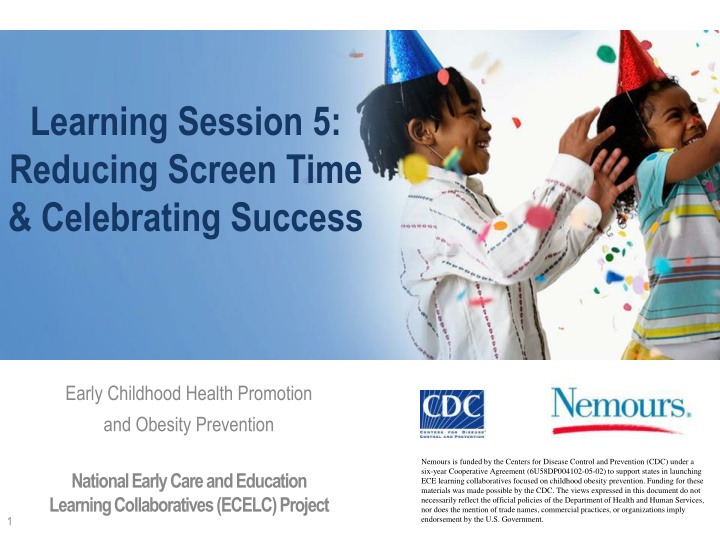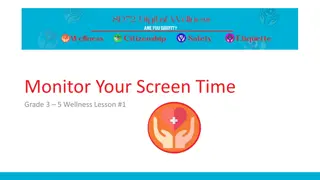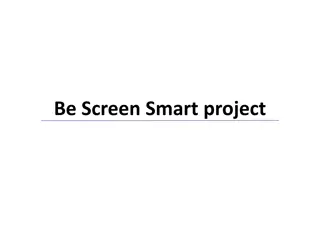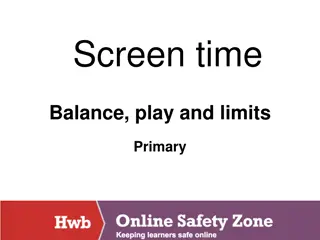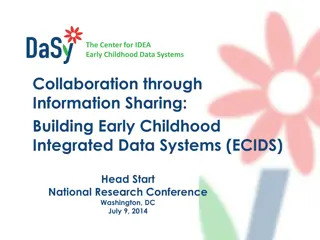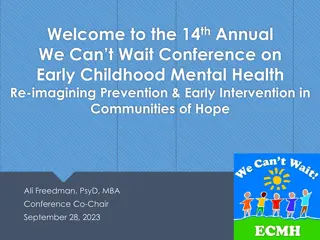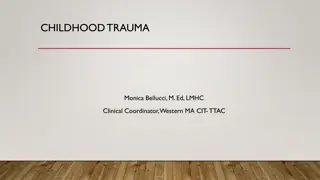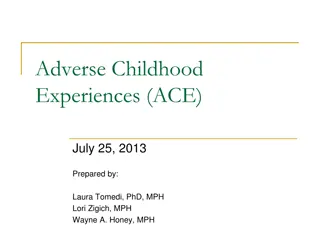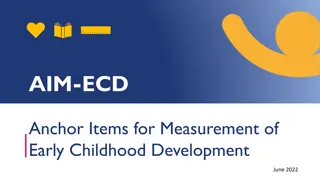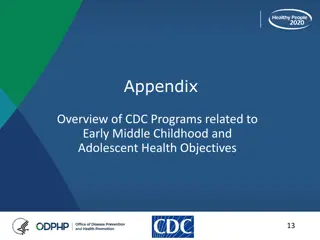Reducing Screen Time & Celebrating Success in Early Childhood Health Promotion
This content discusses the importance of reducing screen time and promoting healthy habits in early childhood. It highlights best practices, objectives, and support resources for providers. The focus is on fostering a healthy environment for young children to prevent obesity.
Download Presentation

Please find below an Image/Link to download the presentation.
The content on the website is provided AS IS for your information and personal use only. It may not be sold, licensed, or shared on other websites without obtaining consent from the author.If you encounter any issues during the download, it is possible that the publisher has removed the file from their server.
You are allowed to download the files provided on this website for personal or commercial use, subject to the condition that they are used lawfully. All files are the property of their respective owners.
The content on the website is provided AS IS for your information and personal use only. It may not be sold, licensed, or shared on other websites without obtaining consent from the author.
E N D
Presentation Transcript
Learning Session 5: Reducing Screen Time & Celebrating Success Early Childhood Health Promotion and Obesity Prevention Nemours is funded by the Centers for Disease Control and Prevention (CDC) under a six-year Cooperative Agreement (6U58DP004102-05-02) to support states in launching ECE learning collaboratives focused on childhood obesity prevention. Funding for these materials was made possible by the CDC. The views expressed in this document do not necessarily reflect the official policies of the Department of Health and Human Services, nor does the mention of trade names, commercial practices, or organizations imply endorsement by the U.S. Government. National Early Care and Education Learning Collaboratives (ECELC) Project 1
Acknowledgements A special thank you to: Centers for Disease Control and Prevention (CDC) For generous funding support and expertise Nemours For their expertise, materials, support, and time spent on the project s implementation Gretchen Swanson Center for Nutrition For the evaluation component of this national effort 2
Learning Session 5 Objectives At the end of the Learning Session, providers will be able to: 1. Describe best practices for reducing screen time and identify change opportunities within their program; 2. Use storyboard presentations to show at least one change within their program that supported healthy eating, physical activity, screen time, and breastfeeding support; 3. Be able to identify local organizations/agencies that support family child care providers; and 4. Be prepared to continue their Action Plan to support implementation of best practices for healthy eating, physical activity, screen time and breastfeeding support in their program. 3
Learning Session 5 Serving Meals Family-Style & Supporting Breastfeeding The ABC s of a Healthy Me! Reducing Screen Time & Celebrating Success Continue Action Plan & Storyboard Go NAP SACC* Continuing the process of change Action Period Action Period Action Period Action Period Action Period LS1 LS2 LS3 LS4 LS5 Getting Kids Moving Nurturing Healthy Eaters & Providing Healthy Beverages Continue Action Plan & Storyboard Action Plan 4 *Go NAP SACC is a Nutrition and Physical Activity Self Assessment for Family Child Care for FCC providers comparing their current practices with a set of best practices
Presenting Storyboards
Part A: Best Practices for Screen Time 8
What is Screen Time? What is screen time? TV, DVDs, videos Computer time Smart phone, tablets Video games Virtual reality headsets 9
What are the concerns about screen time? While watching television may be an enjoyable activity, children lack the ability to gain educational value from it Moderation of screen time is key for healthy development and staying active Instead of spending time watching screens, children should be engaging in physical activity and or educational activities 10
Screen Time Rationale Gets in the way of exploring, playing, and social interaction Children who spend more time watching TV are more likely to be overweight or obese For children 8-16 months, every hour of viewing is associated with 6-8 fewer words learned More hours of viewing at age 3 can lead to decreased cognitive test scores at age 6 11
Make the Most of Screen Time Technology is everywhere, so if it is used for no more than 30 minutes per week in your program choose strategies that support children s development Make screen time interactive talk about what you re viewing and ask children to act out what they see Point out new words, letters, and concepts Discuss the issues the main characters face and how they overcome them Help the child connect what they re viewing to the real world Have children take turns using a device to teach them about sharing
Make the Most of Screen Time Choose strategies for including screen time that support children s healthy development. Screen time should be playful and support creativity, exploration, pretend play, active play and outdoor activities. Ensure that: Screen time does not take the place of healthier activities. Children are at a developmentally appropriate level to engage in the technology. Children explore the use of the various technologies available to them before use. 13
Interactive Screen Time Interactive screen time = television programs, internet, tablets, e-books, applications (apps) and other content intended to encourage active and creative use to enhance social development among children and adults Interactive screen time strategies that support children s healthy development: Talk about what you re viewing, ask children to act out what they see Point out new words, letters, and concepts Discuss the issues characters face and overcome Help children connect what they view to the real world Have children take turns using a device to teach them about sharing 14
Intentional Screen Time Intentional screen time = ECE providers using screen time in a purposeful, thoughtful, and appropriate way to enhance and extend curriculum, meet learning standards, and support individual children s learning Intentional screen time practices that support children s healthy development Plan ahead Think about and set learning goals Preview and evaluate the media selection Select media that will help children make connections with their peers and community Offer breaks that transition the activity on the screen to a hands-on, real world activity. 15
Best Practices for Screen Time Don t allow any screen time for children less than two years. Babies and even toddlers (up to two years old) shouldn t get any screen time at all, according to the American Academy of Pediatrics Activities that are active, social, and engage a child s senses such as touching, exploring, and playing are much more beneficial for brain development than watching television 16
Best Practices for Screen Time Limit total screen time in ECE for children two years and older to no more than 30 minutes per week for educational or physical activity purposes only. The American Academy of Pediatrics recommends one hour or less of total screen time each day for children older than two On average, preschool aged children watch about 4 hours of screen time, with the majority of it being watched at home It s best to minimize screen time in ECE, to no more than 30 minutes per week to reduce the total amount of time children spend in front of screens Many programs choose not to have any screen time for any children 17
Best Practices for Screen Time Screen time should not be utilized during meal or snack time Socializing during meals and snacks is an important part of children's healthy development and is an opportunity for positive role modeling Time during meals should be spent modeling appropriate eating behaviors and habits, encouraging children to try new foods, talking about nutrition, and supporting the development of children s gross and fine motor skills (e.g., self-serving of food) 18
Best Practices for Screen Time Ensure that any screen media used is free of advertising and brand placement Advertising influences the food consumption of young children, and for everyone one-hour increase in TV viewing per day, children drink more sugar- sweetened beverages, eat more fast food, and consume more calories overall Be sure to review all media prior to use to make sure it is free of all advertising and branding 19
Best Practices for Screen Time Educate parents on how to reduce screen time, or teach media literacy education* two times per year or more*Education opportunities can include special programs, newsletters, or information sheets Many parents are not familiar with current screen time recommendations for children It is important to educate parents about screen time, but also to partner with them to ensure children are not being exposed to too much screen time throughout the day On average, children under two spend about 45 minutes in front of screens daily, and preschool aged children spend about 4 hours a day in front of a screen daily, most of which occurs at home. 20
Screen Time In the Program Digital technology can support dual language learners Various forms of technology can be beneficial when working with children with special needs Include cameras, phones and radios in exploratory centers Children have the opportunity to explore various forms of technology and can enhance gross and fine motor skill development 21
Ways to ut Down on Screen Time Nutrition and Wellness Tips for Young Children: Provider Handbook for the Child and Adult Care Food Program Activities to Limit Screen Time: Play music: have children create their own dances Organize puzzle time Conduct a pretend play activity Draw, color, create a sculpture or use playdough Provide a sack of special activities: put together a box containing activities children do not normally engage in 22
Screen Free Moments: Promoting Healthy Habits 23
Part B: Extending Your Learning - The Provider, Families and Program Policies 24
Families and Screen Time Best practices to keep in mind include: Set expectations. Communicate physical activity and screen time polices when children enroll, and regularly throughout the year Provide education to families on developmental milestones, ways to support physical activity, and how to reduce screen time Give families regular feedback on their children s progress related to gross motor skill development and developmental milestones Work with families to adapt activities for children with physical or developmental disabilities 25
Reducing Screen Time at Home There are many ways to work with families to reduce screen time at home. Here are five examples: 1. Hold an annual family training at your child care center 2. Recommend activities that promote interaction between parents and their child and among family members. 3. Provide activity ideas that do not require direct participation of a parent 4. Provide suggestions for how families might adjust their home environment to help limit screen time 5. Encourage families to limit screen time to quality, educational programming 26
Personal Wellness and Screen Time There are many ways that you and your staff can cut down on your personal screen time use: Log your personal screen time and set goals to cut down! Turn your phone off from time to time to take mental breaks Turn off the TV during mealtimes Focus on other activities Find different ways to unwind (e.g., listening to music) Take up a new, active hobby. Plan screen-free activities with family and/or friends 27
Screen Time Policy Have comprehensive screen time policies Written policies help everyone to have a clear and shared understanding of how your program supports reducing screen time Be sure to regularly communicate policies for screen time to families along with all other program policies.
Screen Time Policy To be comprehensive, policies should include these best practices: Don t allow any screen time for children less than two years. Limit total screen time in ECE for children two years and older to no more than 30 minutes per week for educational or physical activity purposes only. Screen time should not be utilized during meal or snack time. Ensure that any screen media used is free of advertising and brand placement. Educate families on how to reduce screen time or teach media literacy education two times per year or more. 29
Part C: Continuing the Process of Change 30
Part D: National, State, and Local Support 34
Supplemental Nutrition Assistance Program-Education (SNAP-Ed) How can it help me? Encourages participation in food and nutrition assistance programs Provides parent education Offers tools and resources to distribute to families Encourages partnerships with community organizations What is it? Program that supports nutrition education for eligible participants State regulated Educates and encourages participants to make healthy food choices Provides information, training, and additional resources 35
Expanded Food and Nutrition Education Program (EFNEP) How can it help me? Offers workshops to educate families on: Food safety Nutrition Physical activity Buying food on a budget Provides tools and resources to help individuals and families lead healthier lives What is it? Program designed for individuals with limited resources in acquiring the knowledge, skills, and attitudes useful in establishing nutritious diets Offers programs including Adult EFNEP Youth EFNEP Program Delivery 36
Women, Infants, and Children (WIC) What is it? Program that provides nutritious foods, education and counseling, and screening and referrals to participants Target population are low income, nutritionally at risk pregnant women, breastfeeding and non breastfeeding women, post-partum women, infants and children How can it help me? Provides funds for women and children for supplemental nutritious foods Offers one-on-one nutrition counseling to participants Provides referrals to other health and social services if needed 37
Child and Adult Care Food Program (CACFP) How can it help me? Save money on food purchased for meals Receive resources on nutrition and healthy eating Supports healthy child development If feeding a mother s breast milk, CACFP participating programs can receive a reimbursement What is it? Federally-funded program administered by the State Provides partial reimbursement for meals for infants and children enrolled in ECE programs who serve children in low-income areas 38
Quality Rating & Improvement System (QRIS) How can it help me? Increase the quality of your program Potentially receive incentives for participation Save costs through enrollment in financial assistance programs Have continued support through technical assistance What is it? Standards that are designed to assess, improve, and communicate the level of quality of ECE programs and communicate ratings to the public Standards can be county- or statewide Uses a rating scale to assess level of quality 39
Child Care Aware of America How can it help me? Increase enrollment Provide staff training Assist in developing a business and management plan Serve as a marketing tool What is it? An agency that works with state and local Child Care Resource and Referral agencies (CCR&R) to ensure that all families have access to affordable child care and assistance to locate them 40
Licensing Regulations How can it help me? Maintain a child care license when in compliance Provides technical assistance Informs parents of requirements that must be met What is it? A set of minimum guidelines regulated by the state that monitor the health and safety of licensed: Child care programs Family child care Community based programs Faith based programs Head Start programs Supported by the state 41
Early Intervention Programs How can it help me? Provides support to children with developmental delays Assists in finding special educational services for children Works with families to provide resources and support Provides resources and training to staff What do they do? Designed to address the educational and developmental needs of very young children with disabilities and those experiencing developmental delays Provides free developmental evaluations of children under three 42
Check-Out 43
